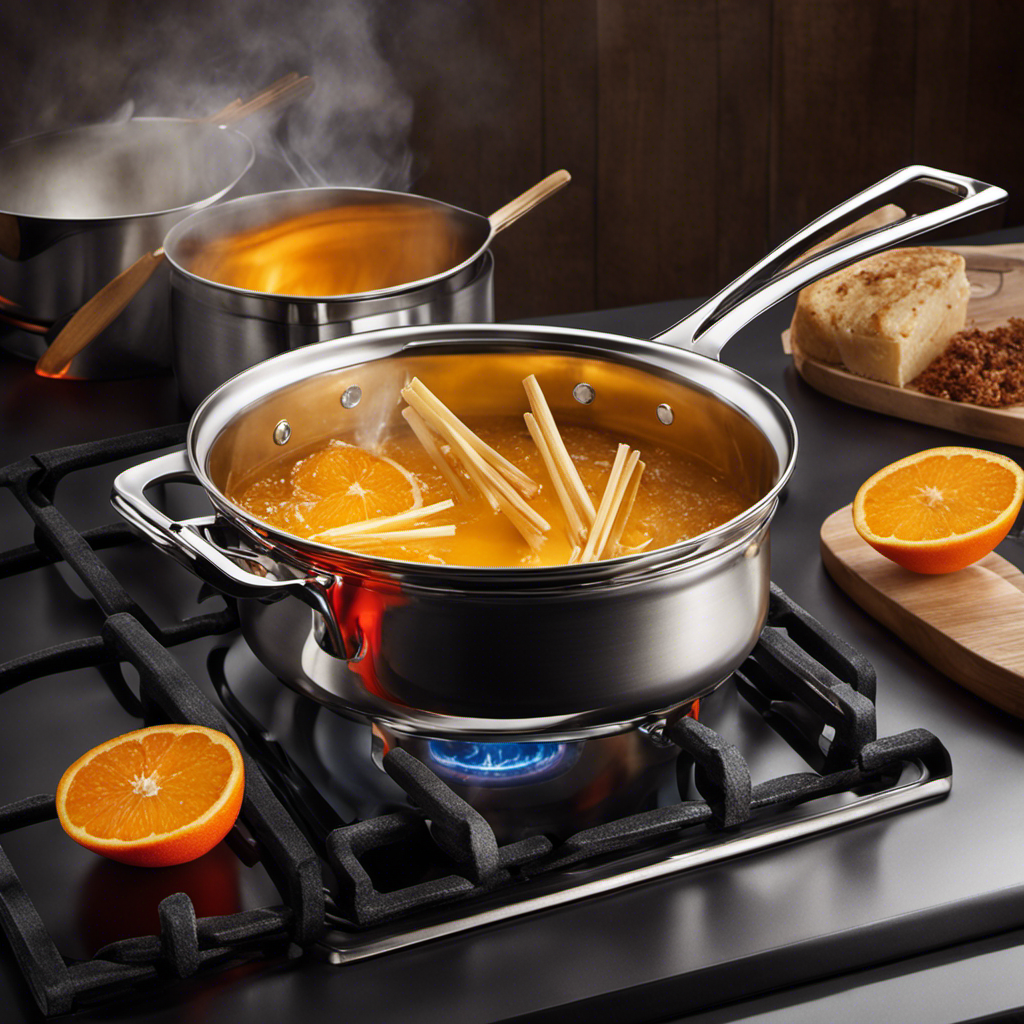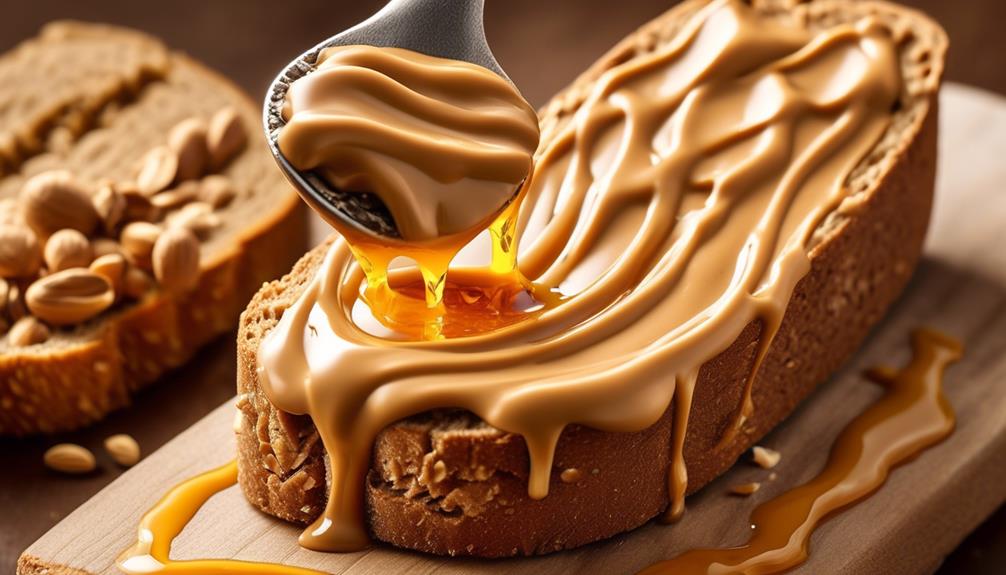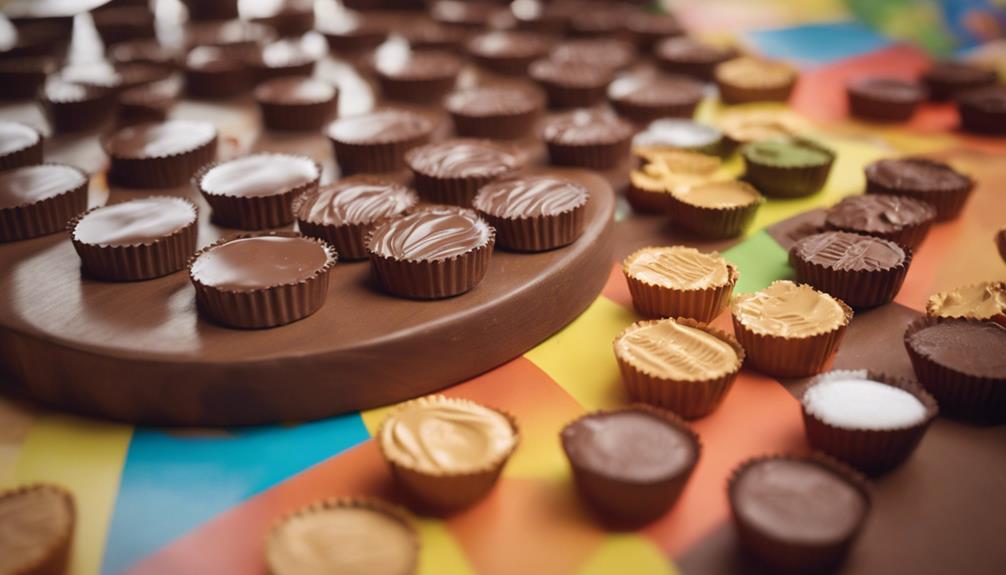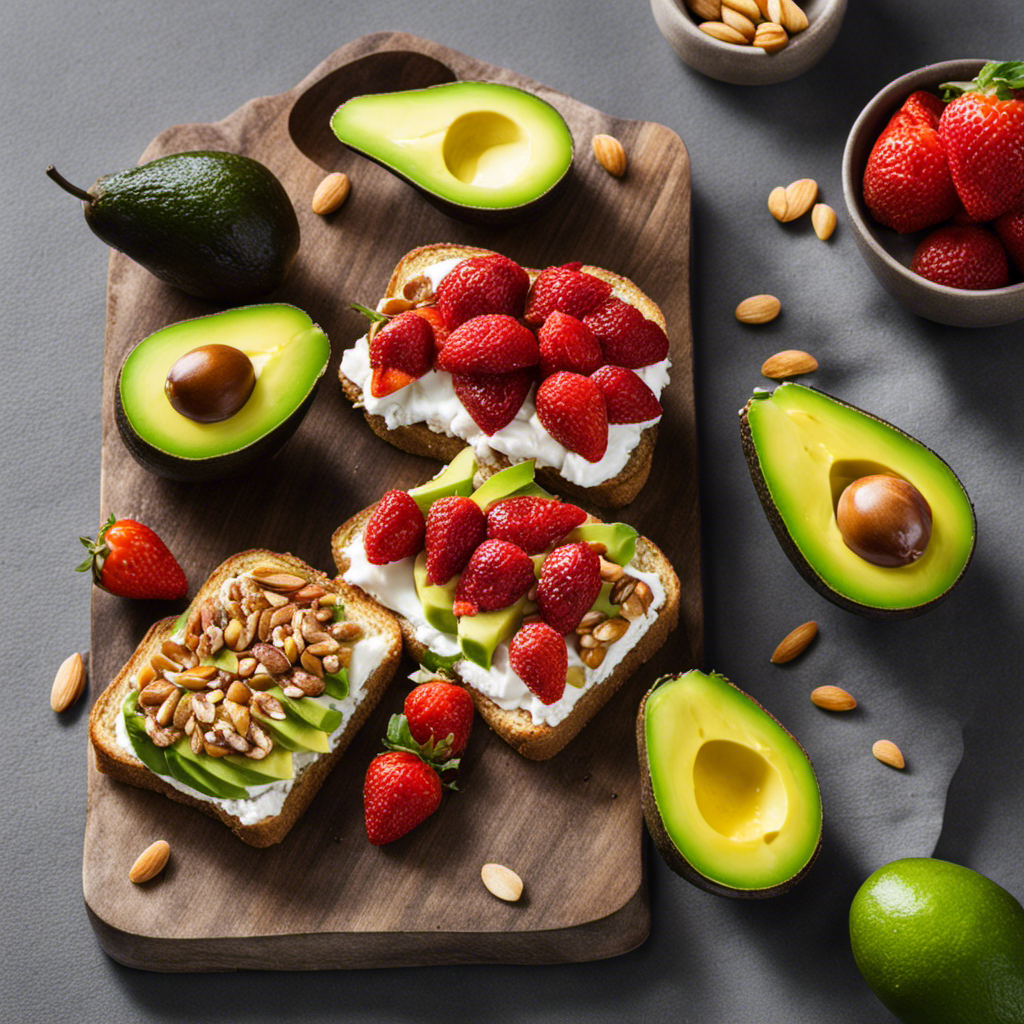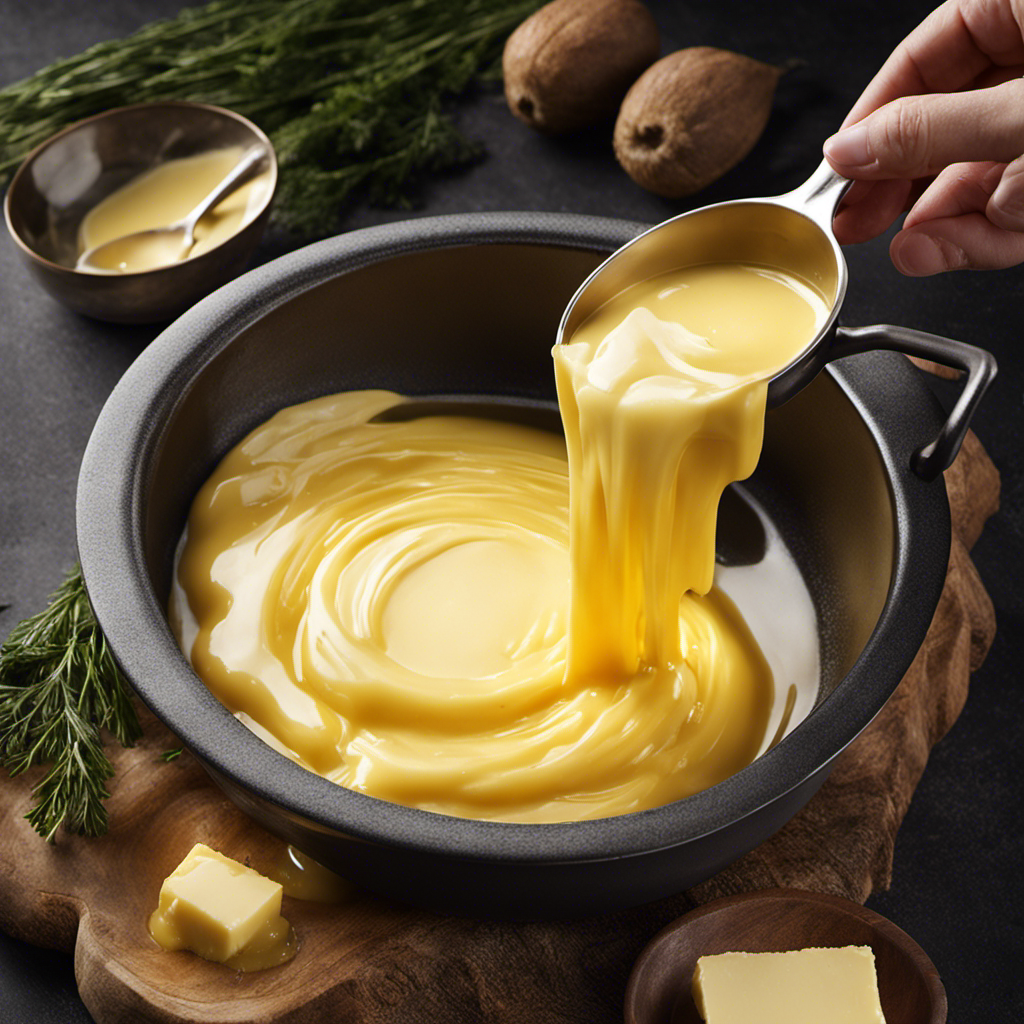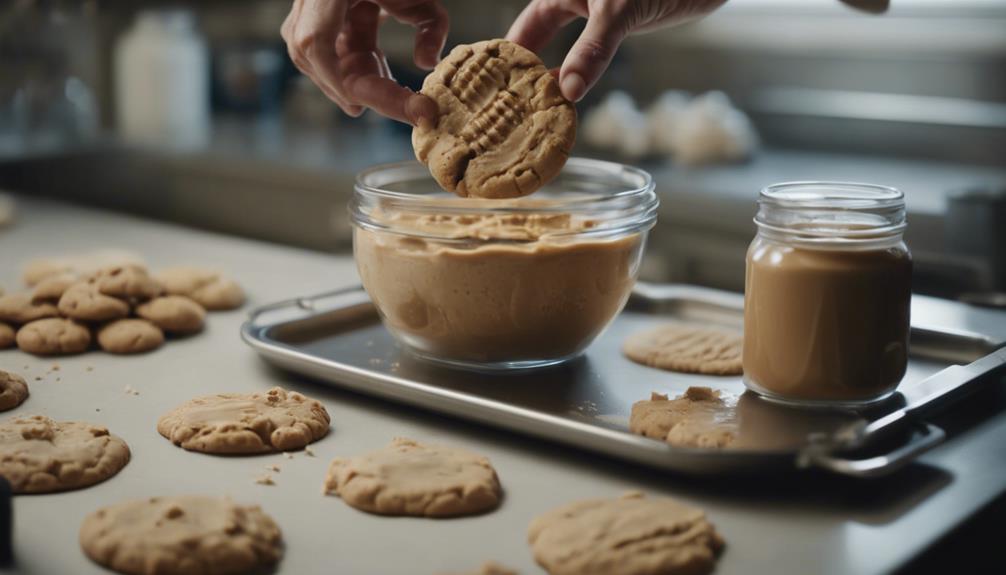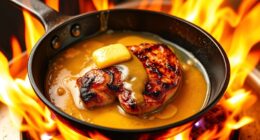I absolutely adore treating myself to a tasty dish of crab legs, but what truly elevates the experience is a decadent and flavorful butter sauce. In this article, I will demonstrate how to create the ideal butter accompaniment for your crab legs.
We’ll start by selecting the right butter and gathering all the necessary ingredients. Then, we’ll prepare the butter mixture, adding in some flavor enhancers and incorporating herbs and spices for that extra kick.
Get ready to impress your taste buds with this homemade lemon butter sauce that will keep your crab legs warm and ready to be devoured. Let’s dive in!
Key Takeaways
- Select high-quality, unsalted butter for balanced flavor and consider experimenting with flavored butters like garlic, lemon, or herb.
- Use fresh ingredients, such as unsalted butter, fresh lemon juice, and minced garlic, for maximum flavor.
- Consider alternatives like vegan butter or olive oil for dietary restrictions.
- Enhance the butter mixture with flavor enhancers like minced garlic, chopped parsley, dried herbs, cayenne pepper, paprika, lemon zest, or hot sauce.
Selecting the Right Butter
When selecting the right butter, it’s important to choose a high-quality, unsalted variety. This ensures that the flavor of the butter won’t overpower the delicate taste of the crab legs.
While some people prefer to use plain butter, others enjoy experimenting with different flavors. Personally, I love trying different butter brands and selecting flavored butters to add an extra layer of taste to my crab legs. Some popular options include garlic butter, lemon butter, and herb butter.
These flavored butters can be found in most grocery stores, or you can even make your own by adding your favorite herbs and spices to softened butter.
Now that we’ve discussed selecting the right butter, let’s move on to gathering the rest of the ingredients.
Gathering the Ingredients
When it comes to creating the perfect butter for crab legs, understanding the essential ingredients is crucial. From the rich creaminess of high-quality butter to the aromatic flavors of herbs and spices, every ingredient plays a role in elevating the overall taste.
However, it’s also worth exploring alternative butter options for those with dietary restrictions or preferences.
Essential Butter Ingredients
To make butter for crab legs, you’ll need a few essential ingredients. Here are the key components:
-
Unsalted butter: This is the base of the butter sauce and provides a rich and creamy texture.
-
Fresh lemon juice: The acidity of lemon juice adds a tangy freshness to the butter and complements the sweetness of the crab meat.
-
Minced garlic: Garlic adds a savory note and enhances the overall flavor profile of the butter sauce.
When it comes to butter, there are alternative options like vegan butter or olive oil for those with dietary restrictions or preferences. However, the freshness of the ingredients is crucial. Using high-quality, fresh butter, lemon juice, and garlic will elevate the taste of your butter sauce and enhance the experience of enjoying crab legs.
Alternative Butter Options
Using vegan butter or olive oil as alternatives can accommodate dietary restrictions or preferences without sacrificing flavor.
When it comes to alternative butter options, there are a variety of choices available. Vegan butter, made from plant-based oils, is a popular option for those following a vegan or dairy-free diet. It has a creamy texture and a rich, buttery taste.
Olive oil, on the other hand, is a healthier alternative that adds a unique flavor to dishes. It can be used as a spread, in baking, or for sautéing vegetables.
For those looking to get creative with their butter recipes, there are endless possibilities. You can add herbs, spices, or even sweet ingredients like honey or maple syrup to create delicious flavored butters.
Importance of Ingredient Freshness
You’ll want to ensure that the ingredients you use are fresh in order to maximize the flavor and quality of your dishes. When it comes to ingredient sourcing, freshness indicators are key.
Here are three reasons why using fresh ingredients is crucial:
-
Enhanced Flavor: Fresh ingredients have a vibrant taste that can elevate your dish to new heights. The natural flavors are more pronounced and provide a delightful burst with every bite.
-
Nutritional Value: Fresh ingredients retain their nutrients, ensuring that you receive the maximum health benefits from your meal. They are packed with vitamins, minerals, and antioxidants that contribute to your overall well-being.
-
Quality Assurance: Fresh ingredients are a sign of quality. By using fresh produce, meats, and spices, you can be confident that you are serving your loved ones the best possible meal.
Preparing the Butter Mixture
Once you have gathered all the necessary ingredients, start by melting the butter in a saucepan. Temperature control is crucial when preparing the butter mixture for crab legs.
Different types of butter can be used, such as unsalted butter, clarified butter, or even flavored butter. It is important to melt the butter over low heat to prevent it from burning or separating. This ensures that the butter maintains its smooth and creamy texture.
While melting the butter, it is essential to monitor the temperature carefully. Too high of a temperature can result in the butter becoming greasy and losing its flavor. On the other hand, if the heat is too low, the butter may not melt completely.
Proper temperature control guarantees that the butter is perfectly melted and ready to enhance the flavor of the succulent crab legs.
Adding Flavor Enhancers
To enhance the flavor, it’s important to consider different flavor enhancers that can be added to the melted butter. Incorporating seasonings can elevate the taste of the butter and complement the succulent crab legs perfectly. Here are three flavor enhancers that will make your butter mixture shine:
-
Garlic and herbs: By adding minced garlic, chopped parsley, and a sprinkle of dried herbs like thyme or oregano, you’ll infuse the butter with a savory and aromatic taste that will tantalize your taste buds.
-
Spices: For a touch of heat and complexity, try adding a pinch of cayenne pepper or paprika to the melted butter. These spices will give your butter a subtle kick and depth of flavor.
-
Citrus zest: Brighten up the butter mixture by grating some lemon or lime zest into it. The citrus flavors will add a refreshing and tangy element that pairs beautifully with the sweet crab meat.
Incorporating Herbs and Spices
When it comes to enhancing flavor in my cooking, I always turn to herbs and spices.
Using fresh herbs like basil, thyme, or rosemary can bring a burst of freshness to any dish, while experimenting with spice blends adds depth and complexity.
Whether I’m making a simple pasta sauce or a flavorful marinade, incorporating herbs and spices is a surefire way to take my culinary creations to the next level.
Enhancing Flavor With Herbs
Adding herbs is a great way to enhance the flavor of your butter for crab legs. Not only do they add a burst of freshness, but they also provide a delightful aroma that will make your dining experience even more enjoyable.
When it comes to incorporating fresh ingredients into your butter, there are numerous herbs to choose from. Here are three options that I highly recommend:
-
Fresh dill: Its vibrant green color and subtle tanginess complement the delicate taste of crab legs perfectly. It adds a refreshing and herbaceous note to the butter.
-
Chives: These slender green stalks have a mild onion-like flavor that pairs well with seafood. The addition of chives adds a touch of brightness and a subtle hint of sweetness to the butter.
-
Parsley: This versatile herb not only adds a pop of color but also brings a fresh and slightly peppery taste to the butter. It enhances the overall flavor profile of the crab legs.
Experimenting With Spice Blends
Experimenting with spice blends can greatly enhance the flavor of your dish, allowing you to create unique and delicious combinations.
Spice blends are a fantastic way to add depth and complexity to your cooking. With a wide variety of spices available, you can tailor your blends to suit your personal taste preferences.
By experimenting with different combinations, you can discover new and exciting flavors that will elevate your dishes to the next level. Whether you prefer a spicy kick or a milder, more aromatic blend, there is a spice combination out there for you.
Don’t be afraid to get creative and try new things – you might just stumble upon a winning blend that becomes your signature touch in the kitchen.
Adjusting the Saltiness Level
To adjust the saltiness level, you can simply taste the butter and add more or less salt as desired. Adjusting the seasoning of your garlic butter is crucial to achieving the perfect flavor for your crab legs. Here are three reasons why it’s important to get the saltiness just right:
-
Balance: Properly seasoned garlic butter enhances the natural sweetness of crab meat, creating a harmonious balance of flavors that will leave you satisfied.
-
Taste: By adjusting the saltiness, you can tailor the taste of the butter to your liking. Whether you prefer a subtle hint of salt or a bolder flavor, seasoning the butter to your taste will ensure a more enjoyable dining experience.
-
Versatility: Garlic butter variations can be used for various seafood dishes, and adjusting the saltiness allows you to customize the butter to suit different recipes and personal preferences.
Now that we’ve discussed adjusting the saltiness level, let’s move on to the next step: melting the butter.
Melting the Butter
Now, you’ll need to heat up the butter until it melts completely. Melting butter may seem like a simple task, but it’s important to do it properly to achieve the perfect consistency for your garlic butter. Here are some techniques for melting butter that you can try:
| Technique | Description |
|---|---|
| Stovetop Method | Place a saucepan over low heat and add the butter. Stir occasionally until it melts completely. |
| Microwave Method | Cut the butter into small pieces and place them in a microwave-safe bowl. Microwave in 30-second intervals, stirring in between, until melted. |
| Double Boiler Method | Fill the bottom of a double boiler with water and place it over medium heat. Place the butter in the top pan and stir until melted. |
Infusing the Butter With Garlic
When it comes to enhancing the flavor of butter, there are a few techniques that I find particularly effective.
One of my favorites is infusing the butter with garlic, which adds a deliciously aromatic and savory note to any dish.
In addition to discussing the garlic infusion techniques, I also want to explore the art of pairing butter with seafood.
The combination of rich, creamy butter and fresh seafood can create a truly unforgettable culinary experience.
Enhancing Butter Flavor
You can easily enhance the flavor of your butter for crab legs by adding a squeeze of fresh lemon juice. The tangy citrus flavor of the lemon complements the sweet and succulent taste of the crab, creating a delicious combination that will tantalize your taste buds.
Here are three ways to further enhance the flavor of your butter:
-
Incorporating citrus flavors: In addition to lemon juice, you can experiment with other citrus fruits like lime or orange to add a unique twist to your butter. The natural acidity and brightness of these fruits bring a refreshing element to the dish.
-
Using infused oils: Infusing your butter with citrus-infused oils, such as lemon-infused olive oil, can intensify the citrus flavor and provide a more pronounced taste. These oils are readily available in stores or can be easily made at home by infusing citrus zest into your favorite oil.
-
Adding herbs and spices: To elevate the flavor profile even further, consider adding herbs like dill, parsley, or chives, along with spices like paprika or cayenne pepper. These additions will add depth and complexity to your butter, making it a standout accompaniment to your crab legs.
By incorporating citrus flavors and using infused oils, you can take your butter for crab legs to the next level.
Now, let’s explore the next section about garlic infusion techniques.
Garlic Infusion Techniques
In my quest to enhance the flavor of butter for crab legs, I delved into the world of garlic infusion techniques. Garlic and butter are a classic combination, and I wanted to explore different ways to infuse the butter with the bold flavors of garlic.
One popular method is to make garlic butter by simply combining melted butter with minced garlic. This creates a rich and aromatic butter that pairs perfectly with seafood.
Another technique involves marinating the butter with garlic. By simmering minced garlic in melted butter over low heat, the butter absorbs the flavors of the garlic, resulting in a more intense and nuanced taste.
The possibilities are endless when it comes to garlic butter recipes, and I can’t wait to share them with you. Now, let’s move on to the next section and explore the perfect pairing of butter and seafood.
Butter and Seafood Pairing
Let’s explore the delicious pairing of butter and seafood and discover the perfect combination of flavors.
When it comes to seafood, butter is an essential ingredient that enhances the taste and texture of dishes. Here are three reasons why the butter and seafood pairing is so incredible:
-
Richness: Butter adds a luxurious richness to seafood, enhancing its natural flavors and creating a luscious mouthfeel. It brings out the sweetness in shrimp, the brininess in oysters, and the succulence in lobster.
-
Balance: The creamy, smooth texture of butter balances the bold flavors of seafood, creating a harmonious blend of tastes. It helps to mellow out any excessive saltiness or spiciness, allowing the delicate flavors of the seafood to shine through.
-
Versatility: Butter can be flavored with various ingredients like garlic, lemon, herbs, or spices, adding layers of complexity to the seafood dishes. Flavored butter infuses the seafood with additional aromatic notes, taking the flavor profile to new heights.
By using flavored butter in your seafood dishes, you not only enhance the taste but also add a touch of elegance and sophistication to your meals.
Creating a Lemon Butter Sauce
To create a tangy lemon butter sauce for your crab legs, squeeze fresh lemon juice into melted butter and stir until well combined.
This simple yet flavorful sauce adds a zesty kick to your seafood dish.
If you’re looking to switch things up, there are various lemon butter variations you can try. For a hint of sweetness, add a touch of honey or maple syrup to the sauce.
For a spicy twist, incorporate some crushed red pepper flakes or a dash of hot sauce.
Now, if you’re looking to make a healthier version of this sauce, you can use butter substitutes like olive oil or coconut oil. These alternatives still provide a rich and creamy texture while reducing the saturated fat content.
Keeping the Butter Warm
Keep your butter warm by placing it in a small saucepan on low heat, stirring occasionally to prevent it from burning. This is a crucial step in ensuring that your butter remains smooth and creamy, ready to be drizzled over your succulent crab legs.
To enhance the dining experience, here are some serving suggestions that will surely make your butter even more irresistible:
-
Add a squeeze of fresh lemon juice to your warm butter for a tangy twist that complements the sweetness of the crab meat.
-
Sprinkle some chopped parsley or chives over the butter to add a pop of color and a hint of freshness.
-
For a spicy kick, mix in a pinch of cayenne pepper or a few drops of hot sauce to your warm butter.
Serving and Enjoying the Butter With Crab Legs
Now that you’ve learned how to keep the butter warm, let’s talk about serving and enjoying it with your delicious crab legs.
There are a few serving techniques that can enhance your dining experience. Firstly, make sure to have small individual bowls or ramekins for each person to hold their melted butter. This allows everyone to have their own portion and avoids any cross-contamination.
Additionally, consider offering a variety of dipping sauces to complement the butter. Some popular options include lemon garlic butter, spicy Cajun butter, or even a tangy cocktail sauce. These sauces can add an extra layer of flavor and excitement to your crab legs.
Frequently Asked Questions
How Long Can the Prepared Butter Mixture Be Stored?
The prepared butter mixture can be stored for up to two weeks in the refrigerator. It is important to store it in an airtight container to maintain its freshness and flavor. Proper storage ensures an extended shelf life.
Can I Use Margarine Instead of Butter?
Sure, you can use margarine instead of butter for crab legs. While butter adds richness, margarine can be a suitable alternative. Just ensure it’s the same consistency and flavor to enhance your seafood dishes.
What Are Some Alternative Flavor Enhancers I Can Use?
Some alternative ingredients for flavored butter include herbs, spices, and citrus zest. Creative ways to season crab legs include using Old Bay seasoning, garlic butter, or a spicy chili-lime blend.
Can I Use Dried Herbs and Spices Instead of Fresh Ones?
Using dried herbs and spices in butter for crab legs can be a convenient and flavorful option. However, the intensity of flavors may vary, and some dried herbs and spices may lose their potency over time.
How Do I Reheat the Butter if It Becomes Solid Again?
If my butter becomes solid again, I simply pop it in the microwave for a few seconds or heat it gently on the stovetop. To prevent solidification, keep it in a warm place or use a butter warmer.
Conclusion
In conclusion, making your own butter for crab legs is a simple yet satisfying process. By carefully selecting the right ingredients and infusing them with flavorful enhancers like herbs, spices, garlic, and lemon, you can create a delectable sauce that perfectly complements the sweet and succulent taste of crab.
Whether you’re hosting a fancy dinner party or simply indulging in a special meal for yourself, this homemade butter will elevate your crab leg experience to new heights.
So go ahead, dive into the world of homemade butter and savor every buttery bite.
